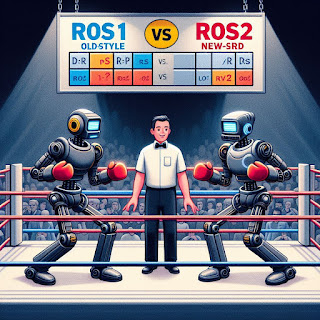- Get link
- X
- Other Apps
ROS (Robot Operating System) is a flexible framework for writing robot software. ROS1 and ROS2 are two major versions of the Robot Operating System, each with its own characteristics and improvements.
Here's a brief comparison between ROS1 and ROS2:
Middleware:
- ROS1: Primarily uses the middleware called ROS Middleware (ROS-Middleware) based on DDS (Data Distribution Service), commonly using the package called "roscpp" for C++ and "rospy" for Python.
- ROS2: Uses a more modular middleware approach with DDS implementations as the default communication middleware. DDS implementations include Fast RTPS, Connext DDS, and others.
Communication:
- ROS1: Publish/subscribe communication model with a master node managing the communication between different nodes.
- ROS2: Maintains a more advanced and decentralized communication model. Nodes can communicate directly without relying on a central master. This improves fault tolerance and scalability.
Real-Time and Performance:
- ROS1: Was not designed with real-time capabilities in mind, which can be a limitation for certain robotic applications.
- ROS2: Introduces better support for real-time systems, making it more suitable for applications where low-latency and determinism are crucial.
Security:
- ROS1: Lacks native security features.
- ROS2: Incorporates security features such as authentication and encryption, which are essential for applications in sensitive environments.
Compatibility:
- ROS1: Code written in ROS1 may need modifications to run on ROS2.
- ROS2: Designed with backward compatibility in mind, but there may still be the need for some adaptation of ROS1 code.
Tooling and Ecosystem:
- ROS1: A mature ecosystem with a wide range of packages and libraries.
- ROS2: Growing ecosystem, with efforts to migrate packages from ROS1 to ROS2. However, some packages may still be available only in ROS1.
Development and Maintenance:
- ROS1: Is in maintenance mode, with new developments primarily focused on ROS2.
- ROS2: Is actively developed, with improvements and new features being added.
Community Support:
- ROS1: Has a large and well-established community.
- ROS2: The community is growing, and as more users transition to ROS2, support continues to improve.
When choosing between ROS1 and ROS2, it depends on factors such as the specific requirements of your robotic application, the availability of packages you need, and whether you prioritize features like real-time capabilities or security.
ROS2 is generally recommended for new projects due to its improved features and ongoing development efforts.
